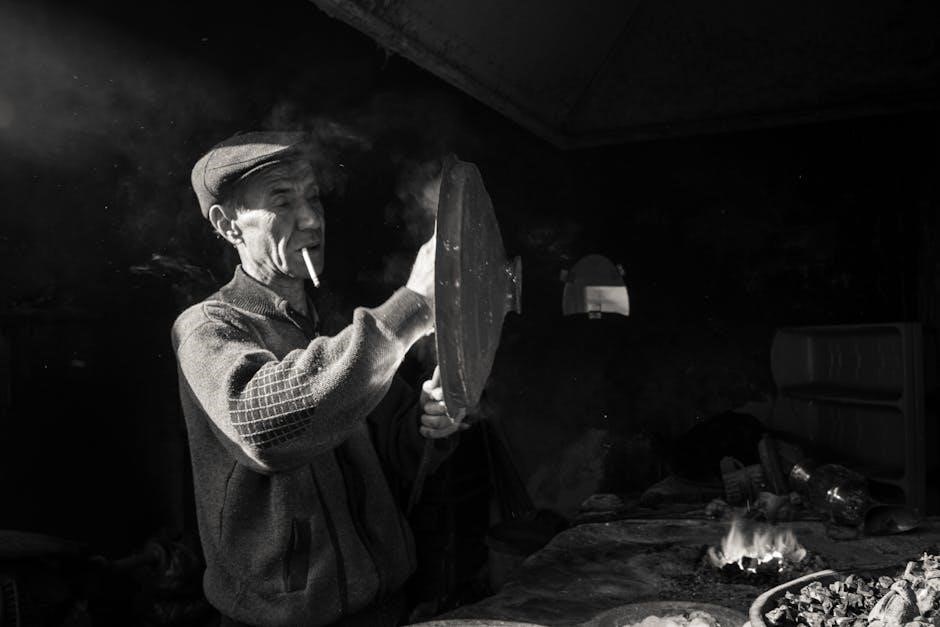Smoke detectors are essential safety devices designed to detect smoke and alert occupants of potential fires, providing crucial early warnings to prevent disasters.
Types of Smoke Detectors
Smoke detectors are categorized into photoelectric, ionization, and smart types, each utilizing distinct technologies to detect smoke and enhance fire safety in various environments effectively.
Photoelectric Smoke Detectors
Photoelectric smoke detectors use a light source to detect smoke particles. When smoke enters the chamber, it scatters the light, triggering an alarm. These detectors are ideal for detecting smoldering fires and are less prone to false alarms compared to ionization types. They are commonly recommended for kitchens and areas near cooking spaces due to their accuracy. Key features include LED indicators for low battery or fault conditions and a test/silence button to check functionality or mute unnecessary alarms. Regular maintenance, such as vacuuming the sensor and replacing batteries, ensures optimal performance. Photoelectric detectors are widely regarded for their reliability and effectiveness in residential and small commercial applications, making them a popular choice for fire safety systems.
Ionization Smoke Detectors
Ionization smoke detectors operate by ionizing air molecules inside the detection chamber. A small amount of radioactive material creates an electric current between two electrodes. When smoke particles enter, they disrupt the current, triggering an alarm. These detectors excel at detecting fast-flaming fires, making them suitable for areas like living rooms and hallways. They are generally more cost-effective and smaller in size compared to photoelectric detectors. However, they are more prone to false alarms caused by cooking fumes or steam. Regular maintenance, such as cleaning the sensor and replacing batteries, is essential for reliable performance. Ionization detectors are a critical component of comprehensive fire safety systems, providing early warning in emergency situations and helping to protect lives and property. Their sensitivity ensures quick response to dangerous fire conditions, enhancing home and workplace safety.
Smart Smoke Detectors
Smart smoke detectors combine traditional fire safety with advanced technology, offering enhanced functionality and connectivity. These detectors are equipped with Wi-Fi or Bluetooth capabilities, enabling integration with smart home systems and mobile apps. They can send real-time alerts to smartphones, providing immediate notifications of potential threats. Many smart detectors feature voice warnings, pinpointing the location of the alarm, and some integrate with voice assistants like Alexa or Google Home. Advanced sensors reduce false alarms by distinguishing between smoke and everyday particles like cooking steam. Maintenance alerts remind users to check battery levels or clean sensors. Smart smoke detectors also support interconnectivity, ensuring all units in a home or building activate simultaneously. Their modern design and seamless integration make them a convenient and reliable choice for comprehensive fire safety. Regular software updates ensure optimal performance and adaptability to new technologies.

Smoke Detector Installation
Install smoke detectors on every level, inside bedrooms, and outside sleeping areas, following NFPA guidelines for optimal coverage and fire safety in your home.
Placement Guidelines
Smoke detectors should be installed on every level of your home, including the basement, with one inside each bedroom and outside every sleeping area. According to NFPA guidelines, detectors should also be placed in living rooms or near stairways on levels without bedrooms. Ensure detectors are at least 500mm away from walls and 500mm clear space around them to avoid obstruction. Avoid installing detectors in kitchens, bathrooms, or areas prone to steam or humidity, as this may cause false alarms. For sloped ceilings, detectors should be placed within 300mm of the peak. Proper placement ensures optimal smoke detection and early warning, enhancing home safety and compliance with fire safety standards.
Installation Steps
- Choose the correct location for the smoke detector based on placement guidelines.
- Turn off the power supply if installing a hardwired detector to avoid electrical hazards.
- Attach the mounting bracket to the ceiling or wall using screws or clips.
- Gently pull the detector away from the base to access the wiring area.
- Connect the wires carefully, ensuring proper polarity for hardwired systems.
- Secure the detector to the mounting bracket and tighten it firmly.
- Replace the battery for battery-powered detectors and ensure it is tightly fitted.
- Turn the power back on and test the detector using the test button.
- Ensure the detector sounds an alarm and that all interconnected units activate.
Always follow the manufacturer’s instructions and local regulations for a safe and correct installation.
Wiring and Connectivity
Proper wiring is crucial for ensuring the functionality of smoke detectors, especially in interconnected systems. For hardwired detectors, connect the live, neutral, and common wires according to the manufacturer’s instructions and local electrical codes; Ensure all connections are secure and insulated to prevent short circuits. Battery-powered detectors eliminate the need for wiring but still require correct battery installation. Interconnectivity allows multiple detectors to communicate, so wiring must be done correctly to ensure all units activate simultaneously. Use the recommended wire gauge and avoid any damage to the cables. Always test the system post-installation to confirm connectivity and functionality. Follow the NFPA guidelines and consult a professional if unsure about wiring procedures.

Maintenance and Testing
Regular maintenance and testing of smoke detectors ensure optimal performance, safeguarding your home and family from potential fire hazards through timely alerts and reliable functionality.
Regular Maintenance Tips
Regular maintenance is crucial for ensuring smoke detectors function properly. Start by cleaning the detector monthly using a vacuum or soft brush to remove dust and debris. Test the alarm by pressing the test button to confirm it emits a loud, clear signal. Replace batteries annually, or as indicated by the manufacturer, especially in battery-powered models. For hardwired detectors, check the wiring for damage or wear. Replace the entire unit every 10 years, as sensors degrade over time. Ensure no obstructions, like curtains or furniture, block the detector’s sensing area. Refer to the manufacturer’s guidelines for specific maintenance instructions tailored to your smoke detector model. Consistent upkeep ensures reliable fire safety and peace of mind for your home and family.
Testing Procedures
Testing your smoke detector ensures it operates correctly during emergencies. Press and hold the test button until the alarm sounds, confirming the device works. For interconnected systems, test one detector to trigger all alarms. Use approved test aerosols or canned smoke to simulate real conditions and check sensitivity. Replace batteries if the low-battery chirp sounds or if the test fails. Check for consistent, loud beeps; weak or irregular sounds indicate potential issues. Test all detectors monthly, especially after installation or battery replacement. Record test dates to stay organized and ensure compliance with safety standards. Regular testing helps identify malfunctions early, ensuring your smoke detectors remain reliable and effective in protecting your home and family from fire hazards. Always follow manufacturer guidelines for specific testing instructions tailored to your smoke detector model.

Troubleshooting Common Issues
Identify and resolve issues like false alarms, chirping sounds, or malfunctioning detectors by cleaning dust, checking expiration dates, and ensuring proper installation and wiring connections.
False Alarms
False alarms in smoke detectors are common issues that can be caused by cooking fumes, steam, or dust particles. To minimize disruptions, ensure detectors are installed at least 10 feet away from cooking appliances and bathrooms. Regular cleaning of the device using a vacuum or soft brush can reduce false triggers. Test alarms monthly and replace batteries annually. If a false alarm occurs, press the mute button if available or wave a towel to clear the air. NFPA guidelines recommend checking for expiration dates, as outdated sensors may malfunction. Always follow the manufacturer’s instructions for troubleshooting and maintenance to ensure reliable performance and safety. Proper placement and regular testing are key to avoiding unnecessary alerts.
Detector Malfunction
A smoke detector malfunction can compromise home safety, often caused by expired sensors, low battery levels, or dust buildup. According to NFPA guidance, detectors should be replaced every 10 years. Check for expiration dates on the device’s label. If a detector is not functioning, test it by pressing the test button. If it fails to sound, replace batteries or the entire unit. Clean detectors regularly with a soft brush or vacuum to prevent dust interference. Ensure proper installation and wiring, as incorrect setup can lead to malfunctions. Refer to the manufacturer’s manual for specific troubleshooting steps. Addressing issues promptly ensures reliable performance and protection. Regular maintenance is crucial for maintaining functionality and safety. Always follow guidelines to prevent potential risks.
Additional Features and Considerations
Modern smoke detectors offer smart integration, voice alerts, and interconnectivity, enhancing safety and convenience. Specialized models cater to specific needs, such as kitchen or large-space coverage.
Interconnectivity and Smart Integration
Interconnectivity allows multiple smoke detectors to link together, ensuring all alarms sound when one detects smoke, enhancing safety and response time.
Smart integration enables detectors to connect with home systems, sending alerts to smartphones and activating smart devices like lights or security systems.
This feature provides real-time monitoring and remote notifications, offering added convenience and peace of mind.
Many modern detectors support voice alerts, identifying the room where smoke is detected, which is especially useful in larger homes.
Proper wiring and configuration are essential for interconnectivity, ensuring seamless communication between devices.
Regular testing of interconnected systems is crucial to maintain reliability and performance.
Smart integration also allows for customization, such as silencing false alarms remotely or adjusting sensitivity levels.
Overall, these advanced features make smoke detectors more effective and user-friendly in modern homes.
Specialized Smoke Detectors
Specialized smoke detectors cater to specific needs, offering enhanced functionality for unique environments.
For instance, smoke detectors designed for kitchens often feature advanced algorithms to reduce false alarms caused by cooking smoke.
Hallway and stairway detectors are equipped with voice alerts, guiding occupants safely during evacuations.
There are also detectors tailored for large industrial spaces, capable of covering extensive areas with multiple sensors.
Some models include features like emergency lights or escape route indicators for improved visibility in low-light conditions.
Specialized detectors may also integrate with other safety systems, such as sprinkler systems or building management software.
They are designed to meet specific fire safety codes and regulations for commercial or industrial settings.
Choosing the right specialized detector ensures optimal performance and compliance with safety standards.
Regular maintenance and testing are crucial to uphold their reliability and effectiveness.
Smoke detectors are a critical component of home and workplace safety, providing early warnings that can save lives and reduce property damage.
Proper installation, maintenance, and testing are essential to ensure their reliability and effectiveness.
By following NFPA guidelines and manufacturer instructions, users can maximize the protection these devices offer.
Regular inspections and compliance with local fire safety codes further enhance their performance.
Interconnected smoke detectors provide comprehensive coverage, ensuring alarms sound throughout the building.
Investing in modern, specialized smoke detectors tailored to specific environments increases safety and peace of mind.
Remember, a functioning smoke detector is the first line of defense against fire hazards.
Stay vigilant, follow the manual, and prioritize safety to protect what matters most.

